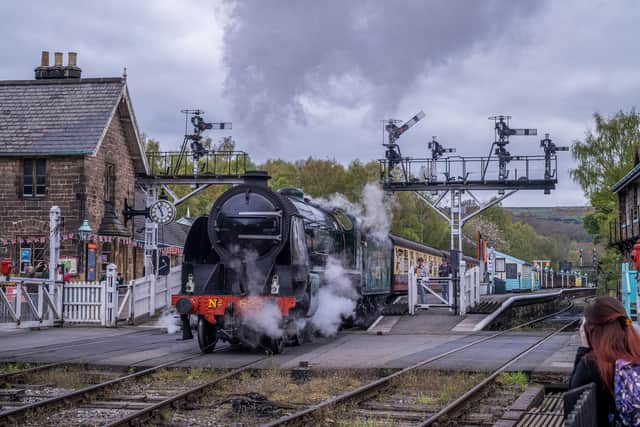North York Moors Railway celebrates 50 years of historic trains and stunning views
On Monday the North York Moors Railway recreated the official opening by the Duchess of Kent in 1973 to celebrate its 50th anniversary, with the same train service and three volunteers reprising their roles on that special day.
Chris Cubitt and Terry Newman, two of the original train crew, drove a double headed special of J27 No. 65894 and Lambton Colliery No. 29 from Platform 3 of Grosmont Station. Meanwhile fellow NYMR veteran John Bruce was busy in the signal box - just as he was all those years ago. Having volunteered for over half a century, the trio are still firing on all cylinders as the NYMR steams into the future.
Advertisement
Hide AdAdvertisement
Hide AdNYMR would have closed for good in 1965 as a result of Dr Beeching’s cuts, which saw 5,000 miles of track and 2,300 stations closed, had it not been for a group of enthusiasts who were convinced it had a future. The line, which takes in the scenic attractions of the North York Moors National Park, now has over 900 volunteers and attracts 300,000 visitors a year.


Terry Newman is probably the longest serving volunteer – his first visit was August 10 1968. He is due to retire from driving steam locos later this year, but will continue volunteering. He said: “I couldn’t even look ahead a year (in 1973) never mind 50 years. It’s gone in a flash. It’s been a wonderful journey. Starting with a volunteer-led organisation, it has grown into a business, and is more business-led than it used to be. It integrates with volunteers and paid staff and between the two there’s an awful lot of hard work and thought gone into things.” The railway announced earlier this year that it was moving towards becoming a “Beamish-style” living history museum due to the high costs of running steam trains on the heritage line.
Terry, who does training and assessment of footplate staff, said they were looking at getting more volunteers dressed in period costume to tell the line’s story: “The main message is we are not sitting on our hands. There are other heritage railways that have been on the go nearly as long as us and are struggling very badly, we are doing well in comparison.”
Getting young people trained up, who have never seen a steam train apart from on a heritage railway or a mainline special, is key: “We look to our future – the only way you can move forward is to have people take your space and it’s a thrill to see them go through that.”
Advertisement
Hide AdAdvertisement
Hide AdMeanwhile Chris Cubitt, who worked for British Railways from 1961, first volunteered at the NYMR in April 1969. He has worked as a cleaner, fireman, driver, inspector and is now a Vice President.
The highlights of his time at the heritage railway? “Probably getting involved with 15 other people and clubbing together to buy locomotive No. 29 - and, of course, meeting my wife.”
